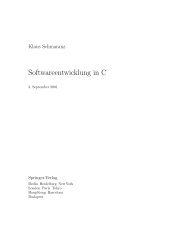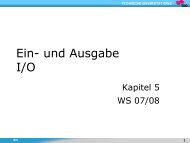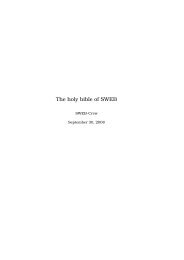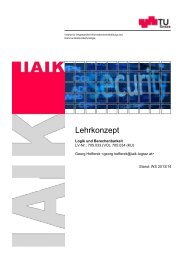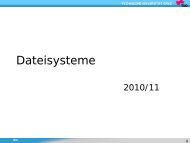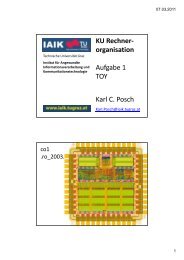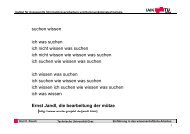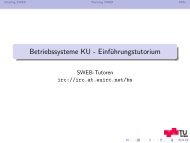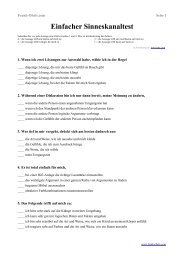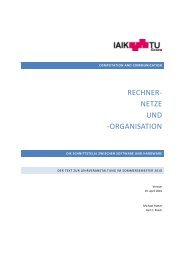Rechnernetze und Organisation
Rechnernetze und Organisation
Rechnernetze und Organisation
Erfolgreiche ePaper selbst erstellen
Machen Sie aus Ihren PDF Publikationen ein blätterbares Flipbook mit unserer einzigartigen Google optimierten e-Paper Software.
IAIK – Institut für Angewandte Informationsverarbeitung <strong>und</strong> Kommunikationstechnologie<br />
<strong>Rechnernetze</strong> <strong>und</strong> <strong>Organisation</strong><br />
<strong>Rechnernetze</strong> <strong>und</strong> <strong>Organisation</strong><br />
Fetch-Execute<br />
Professor Dr. Johannes Horst Wolkerstorfer Cerjak, 19.12.2005<br />
RNO VO02_fetchexecute<br />
1
IAIK – Institut für Angewandte Informationsverarbeitung <strong>und</strong> Kommunikationstechnologie<br />
Übersicht<br />
<strong>Rechnernetze</strong> <strong>und</strong> <strong>Organisation</strong><br />
Motivation<br />
Modulare Computer<br />
– Bussyteme<br />
Fetch and Execute<br />
Einfaches Input/Output<br />
Professor Dr. Johannes Horst Wolkerstorfer Cerjak, 19.12.2005<br />
RNO VO02_fetchexecute<br />
2
IAIK – Institut für Angewandte Informationsverarbeitung <strong>und</strong> Kommunikationstechnologie<br />
Motivation<br />
Prinzipielle Funktionsweise einer CPU<br />
<strong>Rechnernetze</strong> <strong>und</strong> <strong>Organisation</strong><br />
Minimalistischer Prozessor<br />
Professor Dr. Johannes Horst Wolkerstorfer Cerjak, 19.12.2005<br />
RNO VO02_fetchexecute<br />
3
IAIK – Institut für Angewandte Informationsverarbeitung <strong>und</strong> Kommunikationstechnologie<br />
Komponenten eines Computers<br />
<strong>Rechnernetze</strong> <strong>und</strong> <strong>Organisation</strong><br />
Alle Computer gleich aufgebaut<br />
– Prozessor<br />
– Speicher<br />
– Input/Output (IO)<br />
Foto © Opteronix<br />
Computer sind modular<br />
aufgebaut<br />
– Komponenten<br />
• Speicher<br />
• Grafikarten<br />
• ...<br />
... hängen am Systembus<br />
Processor<br />
(CPU)<br />
Memory<br />
Systembus<br />
Input<br />
Output<br />
Professor Dr. Johannes Horst Wolkerstorfer Cerjak, 19.12.2005<br />
RNO VO02_fetchexecute<br />
4
IAIK – Institut für Angewandte Informationsverarbeitung <strong>und</strong> Kommunikationstechnologie<br />
Computer-Aufbau: PC<br />
<strong>Rechnernetze</strong> <strong>und</strong> <strong>Organisation</strong><br />
Pentium CPU<br />
Systembus ist aufgeteilt<br />
– Northbridge<br />
• Schnell<br />
• Für Speicher<br />
• Für Grafikkarte<br />
– Southbridge<br />
• Langsam<br />
• Für PCI-Bus<br />
• Für USB-Bus<br />
• Für Festplatte<br />
– IDE/ATA-Bus<br />
► Computer sind hierarchisch<br />
aufgebaut.<br />
Selbst Busse haben<br />
eine Hierarchie.<br />
Foto © Hardwaregr<strong>und</strong>lagen.de<br />
Professor Dr. Johannes Horst Wolkerstorfer Cerjak, 19.12.2005<br />
RNO VO02_fetchexecute<br />
5
IAIK – Institut für Angewandte Informationsverarbeitung <strong>und</strong> Kommunikationstechnologie<br />
Bussyteme<br />
<strong>Rechnernetze</strong> <strong>und</strong> <strong>Organisation</strong><br />
Gr<strong>und</strong>konzept<br />
– Datenverbindung von Modulen<br />
– Zwei Module können zu einem<br />
Zeitpunkt miteinander<br />
kommunizieren<br />
– Zeitliche Aufteilung der<br />
Kommunikation<br />
Processor<br />
(CPU)<br />
Memory<br />
Systembus<br />
Input<br />
Output<br />
Bus<br />
Adresse<br />
Kontrolle<br />
Daten<br />
– Bündel an Leitungen<br />
– Unidirektional: Adressen<br />
– Bidirektional: Daten<br />
d 0<br />
d 1<br />
d 2<br />
d 3<br />
d 4<br />
d 5<br />
...<br />
d 30<br />
d 31<br />
GND<br />
Professor Dr. Johannes Horst Wolkerstorfer Cerjak, 19.12.2005<br />
RNO VO02_fetchexecute<br />
6
IAIK – Institut für Angewandte Informationsverarbeitung <strong>und</strong> Kommunikationstechnologie<br />
Busse<br />
<strong>Rechnernetze</strong> <strong>und</strong> <strong>Organisation</strong><br />
Vorteile<br />
– Modularer Aufbau<br />
– Skalierbarkeit<br />
– Wiederverwendung von<br />
Ressourcen<br />
• Busleitungen<br />
– Reusability<br />
(„Wiederverwendbarkeit“)<br />
• z.B. Netzwerk-Chip<br />
– Einheitliche Kommunikation<br />
CPU<br />
Memory<br />
Systembus<br />
Grafik<br />
Netzwerk<br />
...<br />
Nachteile<br />
– Throughput Bottleneck („Flaschenhals“)<br />
• Module teilen sich Bus-Bandbreite<br />
– Niedrige Taktfrequenz<br />
Alternative<br />
– N-zu-N Verbindung<br />
• Zu viele Leitungen<br />
– Z.b. N=10 Module mit 32-Bit Bus:<br />
10*(10-1)/2*32 = 1440 Datenleitungen<br />
Memory<br />
CPU<br />
Netzwerk<br />
Grafik<br />
Professor Dr. Johannes Horst Wolkerstorfer Cerjak, 19.12.2005<br />
RNO VO02_fetchexecute<br />
7
IAIK – Institut für Angewandte Informationsverarbeitung <strong>und</strong> Kommunikationstechnologie<br />
Bus-Timing<br />
Was wird in Timing-Diagramm<br />
dargestellt?<br />
– Adressen<br />
– Kontrollsignale<br />
– Daten<br />
– Zeitverhalten<br />
Synchrone Datenübertragung<br />
– Bustakt<br />
• Langsamer als Prozessortakt<br />
Bandbreite von Bussen<br />
– Taktfrequenz * Busbreite<br />
• 33 MHz * 32-Bit = 132 MB/s<br />
<strong>Rechnernetze</strong> <strong>und</strong> <strong>Organisation</strong><br />
Processor<br />
(CPU)<br />
Memory<br />
Systembus<br />
Input<br />
Output<br />
Clk<br />
Addr<br />
R/W<br />
Data<br />
1 2 3<br />
Addr1 Addr2 Addr3<br />
Read Read Write<br />
Instr Data Result<br />
7.5 ns<br />
Professor Dr. Johannes Horst Wolkerstorfer Cerjak, 19.12.2005<br />
RNO VO02_fetchexecute<br />
8
IAIK – Institut für Angewandte Informationsverarbeitung <strong>und</strong> Kommunikationstechnologie<br />
Busbeispiel: PCI<br />
<strong>Rechnernetze</strong> <strong>und</strong> <strong>Organisation</strong><br />
32<br />
AD<br />
– 32-Bit Bus<br />
• Adress- <strong>und</strong><br />
Daten-Multiplexing<br />
– 33 MHz Bustakt<br />
– 132 MB/s Durchsatz<br />
• Maximalwert<br />
4<br />
PAR<br />
C/BE<br />
Parität<br />
Buskommando<br />
Adresse, Daten<br />
PCI-Karte<br />
Idsel<br />
Devsel<br />
Stop<br />
Irdy<br />
Trdy<br />
Frame<br />
Serr<br />
Perr<br />
Kontrollsignale<br />
Gnt<br />
Req<br />
Rst<br />
Clk<br />
Reset<br />
Clock (Takt)<br />
Clk<br />
Frame<br />
AD<br />
C/BE<br />
– Beispiel: Schreibzugriff<br />
• Minimale Transaktion<br />
– Mindestens zwei Takte<br />
» Adressierung<br />
» Datenübertragung<br />
1 2 3 4<br />
Adresse<br />
Daten1<br />
Command BE1 BE2<br />
Adressphase<br />
Datenphase<br />
Daten2<br />
Datenphase<br />
Professor Dr. Johannes Horst Wolkerstorfer Cerjak, 19.12.2005<br />
RNO VO02_fetchexecute<br />
9
IAIK – Institut für Angewandte Informationsverarbeitung <strong>und</strong> Kommunikationstechnologie<br />
Bus-Signale<br />
<strong>Rechnernetze</strong> <strong>und</strong> <strong>Organisation</strong><br />
Input<br />
Analoge Darstellung digitaler<br />
Information<br />
– Als Spannung<br />
Ausbreitungsgeschwindigkeit<br />
– 2/3 Lichtgeschwindigkeit<br />
• 133 MHz: 150 cm (in 7,5 ns)<br />
• 1 GHz: 20 cm (in 1 ns)<br />
Ideal<br />
t<br />
Leitung<br />
Real<br />
t<br />
RC-Effekt<br />
Output<br />
– R: Resistance („Widerstand“)<br />
– C: Capacitance („Kapazität“)<br />
– R, C durch Nichtidealität der<br />
Bauteile (Transistoren,<br />
Leiterbahnen)<br />
– Verzögert Signale<br />
• Delay<br />
• Langsamer Flankenanstieg<br />
Wärme<br />
R<br />
C<br />
Professor Dr. Johannes Horst Wolkerstorfer Cerjak, 19.12.2005<br />
RNO VO02_fetchexecute<br />
10
IAIK – Institut für Angewandte Informationsverarbeitung <strong>und</strong> Kommunikationstechnologie<br />
Digitale Signale<br />
CMOS-Technologie<br />
– CMOS: Complementary<br />
Metal-Oxide Semiconductor<br />
„Komplementärer Metall-Oxyd<br />
Halbleiter“<br />
Logik-Pegel<br />
– Hängen von Spannungsversorgung ab<br />
– CMOS-Schaltungen restaurieren Signal<br />
Gängige Logikpegel (Angaben in Volt)<br />
Eingang<br />
Ausgang<br />
<strong>Rechnernetze</strong> <strong>und</strong> <strong>Organisation</strong><br />
Foto © Wikipedia/Grabert<br />
Technik<br />
CMOS<br />
5V<br />
CMOS<br />
2,5V<br />
CMOS<br />
1,8V<br />
Low<br />
(VIL)<br />
High<br />
(VIH)<br />
Low<br />
(VOL)<br />
High<br />
(VOH)<br />
≤ 1,5 ≥ 3,5 ≤ 0,5 ≥ 4,44<br />
≤ 0,7 ≥ 1,7 ≤ 0,2 ≥ 2,3<br />
≤ 0,7 ≥ 1,17 ≤ 0,45 ≥ 1,2<br />
Professor Dr. Johannes Horst Wolkerstorfer Cerjak, 19.12.2005<br />
RNO VO02_fetchexecute<br />
11
IAIK – Institut für Angewandte Informationsverarbeitung <strong>und</strong> Kommunikationstechnologie<br />
Simple CPU<br />
<strong>Rechnernetze</strong> <strong>und</strong> <strong>Organisation</strong><br />
Microchip PIC16F54<br />
– 8-Bit Controller<br />
– 768 Byte ROM<br />
• Flash-Speicher<br />
– 25 Byte RAM<br />
– 10 MHz Clock<br />
– Preis: 0.44 US$<br />
– 33 Instruktionen<br />
Foto © Microchip<br />
Professor Dr. Johannes Horst Wolkerstorfer Cerjak, 19.12.2005<br />
RNO VO02_fetchexecute<br />
12
IAIK – Institut für Angewandte Informationsverarbeitung <strong>und</strong> Kommunikationstechnologie<br />
Fetch-Execute<br />
<strong>Rechnernetze</strong> <strong>und</strong> <strong>Organisation</strong><br />
Von Neumann Architektur<br />
– Einheitlicher Speicher<br />
• Für Daten <strong>und</strong> Programme<br />
Fetch-and-Execute Algorithmus<br />
– Sequentielle Instruktionsabarbeitung<br />
– Fetch<br />
• Instruktion lesen<br />
• Instruktion dekodieren<br />
• Operanden lesen<br />
– Execute<br />
• Operation ausführen<br />
• Ergebnis speichern<br />
CPU<br />
Control Unit<br />
► Enorme Anzahl an Instruktionen pro Sek<strong>und</strong>e (GHz)<br />
ALU<br />
– Macht aus einfachen Instruktionen komplexe Software<br />
Computer<br />
Memory<br />
Fetch<br />
Execute<br />
Professor Dr. Johannes Horst Wolkerstorfer Cerjak, 19.12.2005<br />
RNO VO02_fetchexecute<br />
13
IAIK – Institut für Angewandte Informationsverarbeitung <strong>und</strong> Kommunikationstechnologie<br />
Fetch-Execute: Komponenten<br />
<strong>Rechnernetze</strong> <strong>und</strong> <strong>Organisation</strong><br />
Was benötigt eine CPU für<br />
Fetch-Execute?<br />
– Control Unit<br />
• Steuert CPU Abläufe<br />
– Datenübernahme von<br />
Registern<br />
– Wählt Operation von<br />
ALU<br />
– Instruction pointer<br />
• Speicheradresse mit<br />
aktueller Instruktion<br />
– Instruction register<br />
• Aktuelle Instruktion<br />
– Memory Address <strong>und</strong><br />
Memory Buffer Register<br />
• Speicher-Interface<br />
– ALU<br />
• Exekutiert Instruktionen<br />
– Register / Akkumulator<br />
• Mini-Speicher für<br />
Operanden <strong>und</strong> Ergebnis<br />
Control Unit<br />
Control<br />
IP<br />
Instr. pointer<br />
IR<br />
Instr. Register<br />
MAR<br />
Mem. addr. Reg.<br />
Address<br />
CPU<br />
MBR<br />
Mem. Buf. Reg.<br />
Data<br />
Memory<br />
EAX<br />
EAX EAX EAX<br />
Accumulator<br />
ALU<br />
Arithm. Logic Unit<br />
Systembus<br />
Professor Dr. Johannes Horst Wolkerstorfer Cerjak, 19.12.2005<br />
RNO VO02_fetchexecute<br />
14
IAIK – Institut für Angewandte Informationsverarbeitung <strong>und</strong> Kommunikationstechnologie<br />
Nach dem Reset<br />
<strong>Rechnernetze</strong> <strong>und</strong> <strong>Organisation</strong><br />
Nach Reset ...<br />
– Stabile Versorgungsspannung<br />
– Stabiler Takt<br />
... beginnt CPU<br />
– Instruktionen<br />
abzuarbeiten<br />
Die erste Instruktion<br />
– Liegt an fixer Adresse<br />
• Meist 0x00000000<br />
Control Unit<br />
Control<br />
IP<br />
Instr. 00000000 pointer<br />
IR<br />
Instr. Register<br />
MAR<br />
Mem. addr. Reg.<br />
Address<br />
CPU<br />
MBR<br />
Mem. Buf. Reg.<br />
Data<br />
Memory<br />
EAX<br />
EAX EAX EAX<br />
Accumulator<br />
ALU<br />
Arithm. Logic Unit<br />
Systembus<br />
Instr. 1 00000005<br />
Instr. 0<br />
00000000<br />
Professor Dr. Johannes Horst Wolkerstorfer Cerjak, 19.12.2005<br />
RNO VO02_fetchexecute<br />
15
IAIK – Institut für Angewandte Informationsverarbeitung <strong>und</strong> Kommunikationstechnologie<br />
Instruction Fetch<br />
<strong>Rechnernetze</strong> <strong>und</strong> <strong>Organisation</strong><br />
Fetch = Holen aktueller<br />
Instruktion aus Speicher<br />
– Instruction pointer zeigt auf<br />
aktuelle Speicheradresse<br />
– 1. Speicher adressieren<br />
• Memory Address Register<br />
– Übernimmt Adresse<br />
von IP<br />
• Lesezugriff auf<br />
Systembus<br />
– 2. Wert auslesen<br />
• Memory Buffer Register<br />
– Übernimmt Wert<br />
(“Datum”) aus Memory<br />
• Instruction Register<br />
– Speichert Instruktion<br />
» Kopie von Memory<br />
Control Unit<br />
Control<br />
read<br />
IP<br />
00000000<br />
Instr. pointer<br />
IR<br />
Instr. Register 0<br />
MAR<br />
Mem. 00000000 addr. Reg.<br />
Address<br />
1.<br />
00000000<br />
CPU<br />
MBR<br />
Mem. Instr. Buf. Reg. 0<br />
Data<br />
Memory<br />
Instr. 0<br />
EAX<br />
EAX EAX EAX<br />
Accumulator<br />
ALU<br />
Arithm. Logic Unit<br />
2.<br />
Systembus<br />
Instr. 1 00000005<br />
00000000<br />
Professor Dr. Johannes Horst Wolkerstorfer Cerjak, 19.12.2005<br />
RNO VO02_fetchexecute<br />
16
IAIK – Institut für Angewandte Informationsverarbeitung <strong>und</strong> Kommunikationstechnologie<br />
Instruction Decode<br />
<strong>Rechnernetze</strong> <strong>und</strong> <strong>Organisation</strong><br />
Decode<br />
– Control Unit<br />
• Erkennt Instruktion am<br />
Opcode<br />
– Z.B. 0x05 = ADD<br />
EAX, immediate<br />
» Addiere<br />
konstanten 32-<br />
Bit Wert zu EAX<br />
Register<br />
• u.U. Fetch von<br />
Operanden nötig<br />
– Weiterer Speicher-<br />
Zugriff nötig<br />
Instruction Pointer<br />
– Wird erhöht sobald<br />
Instruction-Fetch<br />
abgeschlossen<br />
Control Unit<br />
ADD<br />
EAX,<br />
...<br />
Control<br />
IP<br />
Instr. IP++ pointer<br />
IR<br />
Instr. 05 Register<br />
MAR<br />
Mem. addr. Reg.<br />
Address<br />
CPU<br />
MBR<br />
Mem. Buf. Reg.<br />
Data<br />
Memory<br />
EAX<br />
EAX EAX EAX<br />
Accumulator<br />
ALU<br />
Arithm. Logic Unit<br />
Systembus<br />
Professor Dr. Johannes Horst Wolkerstorfer Cerjak, 19.12.2005<br />
RNO VO02_fetchexecute<br />
17
IAIK – Institut für Angewandte Informationsverarbeitung <strong>und</strong> Kommunikationstechnologie<br />
Operand Fetch<br />
<strong>Rechnernetze</strong> <strong>und</strong> <strong>Organisation</strong><br />
Operand Fetch<br />
– Speicherzugriff ähnlich<br />
wie bei Instruction<br />
Fetch<br />
• Immediate Operand<br />
Speicherzugriff<br />
– Folgt immer direkt<br />
auf Instruktions-<br />
Opcode<br />
– Instruction-Pointer<br />
zeigt darauf!<br />
– Immer Sequentiell!<br />
– Memory hat nur ...<br />
• ... einen Adressbus<br />
• ... einen Datenbus<br />
Control Unit<br />
Control<br />
IP<br />
00000001<br />
Instr. pointer<br />
IR<br />
Instr. Register<br />
MAR<br />
Mem. 00000001 addr. Reg.<br />
Address<br />
00000001<br />
CPU<br />
MBR<br />
Mem. 0000008 Buf. Reg.<br />
Data<br />
Memory<br />
EAX<br />
EAX EAX EAX<br />
Accumulator<br />
ALU<br />
Arithm. Logic Unit<br />
Systembus<br />
Instr. 1 00000005<br />
0000008 00000001<br />
05 00000000<br />
Professor Dr. Johannes Horst Wolkerstorfer Cerjak, 19.12.2005<br />
RNO VO02_fetchexecute<br />
18
IAIK – Institut für Angewandte Informationsverarbeitung <strong>und</strong> Kommunikationstechnologie<br />
Execute<br />
<strong>Rechnernetze</strong> <strong>und</strong> <strong>Organisation</strong><br />
Execute<br />
– Control Unit<br />
– ALU<br />
• Wählt ALU-Operation<br />
aus<br />
• Wählt Operanden aus<br />
• Berechnet Operation<br />
– Hier: Addition<br />
– Weitere<br />
Operationen von<br />
ALUs<br />
» Add, Subtract<br />
» Increment, Decr.<br />
» AND, OR, XOR<br />
» Shift left / right<br />
» Rotate left / right<br />
Control Unit<br />
Control<br />
IP<br />
CPU<br />
Memory<br />
EAX<br />
EAX EAX EAX<br />
Instr. IP += pointer 4 Accumulator 0000010<br />
IR<br />
Instr. Register<br />
MAR<br />
Mem. addr. Reg.<br />
Address<br />
MBR<br />
Mem. 0000008 Buf. Reg.<br />
Data<br />
ALU<br />
Arithm. Logic Unit<br />
ADD<br />
0000018<br />
Systembus<br />
Instr. 1 00000005<br />
0000008 00000001<br />
05 00000000<br />
Professor Dr. Johannes Horst Wolkerstorfer Cerjak, 19.12.2005<br />
RNO VO02_fetchexecute<br />
19
IAIK – Institut für Angewandte Informationsverarbeitung <strong>und</strong> Kommunikationstechnologie<br />
Store Result<br />
<strong>Rechnernetze</strong> <strong>und</strong> <strong>Organisation</strong><br />
Store<br />
– Ergebnis speichern<br />
– Ziel:<br />
• Entweder Prozessor-Register<br />
• Oder Speicheradresse<br />
Load / Store Architektur<br />
– Operanden müssen in Register<br />
stehen<br />
• Bei Pentium nicht der Fall<br />
– Ergebnis nur in Register<br />
speichern möglich<br />
• Auch bei Pentium<br />
– Separate Instruktionen für<br />
Memory-Zugriff (load, store)<br />
• Verwenden viele Prozessoren<br />
(RISC)<br />
– Beispiel: memc = mema + memb<br />
• 2 Load-, 1 Store-, 1 Add-<br />
Instruktion nötig<br />
Control Unit<br />
Control<br />
IP<br />
Instr. pointer<br />
IR<br />
Instr. Register<br />
MAR<br />
Mem. addr. Reg.<br />
Address<br />
CPU<br />
MBR<br />
Mem. Buf. Reg.<br />
Data<br />
Memory<br />
EAX<br />
EAX EAX EAX<br />
Accumulator 0000010<br />
ALU<br />
Arithm. Logic Unit<br />
0000018<br />
Systembus<br />
Professor Dr. Johannes Horst Wolkerstorfer Cerjak, 19.12.2005<br />
RNO VO02_fetchexecute<br />
20
IAIK – Institut für Angewandte Informationsverarbeitung <strong>und</strong> Kommunikationstechnologie<br />
Instruktionszyklus<br />
<strong>Rechnernetze</strong> <strong>und</strong> <strong>Organisation</strong><br />
Phasen der Instruktions-<br />
Abarbeitung<br />
1. Fetch instruction<br />
2. Decode instruction<br />
3. Fetch operand<br />
4. Execute operation<br />
5. Store result<br />
Clk<br />
Phase<br />
Instruktion dauert<br />
1 2 3 4<br />
Fetch Decode Operand Exec<br />
– Mehrere Prozessortakte<br />
– Meist 5 oder 6 Takte<br />
Memoryzugriffe bilden<br />
Flaschenhals<br />
Instruction Cycle<br />
5<br />
Store<br />
Professor Dr. Johannes Horst Wolkerstorfer Cerjak, 19.12.2005<br />
RNO VO02_fetchexecute<br />
21
IAIK – Institut für Angewandte Informationsverarbeitung <strong>und</strong> Kommunikationstechnologie<br />
Pre-Fetching<br />
<strong>Rechnernetze</strong> <strong>und</strong> <strong>Organisation</strong><br />
Beschleunigt Fetch-Execute<br />
Algorihtmus<br />
– Nutzt leere Buszyklen ...<br />
• Zyklen ohne Speicherzugriff<br />
– ... Zum Fetchen der nächsten<br />
Instruktion<br />
Benötigt<br />
– Zusätzlichen Speicher in CPU<br />
IR<br />
Instr. Register<br />
• Pre-fetch queue<br />
Fetch1<br />
Fetch2<br />
Exec1<br />
Fetch3<br />
Exec2<br />
Pre-Fetching<br />
– Parallelisiert Abarbeitung von<br />
Instruktionen<br />
Probleme<br />
– Programmverzweigungen<br />
• Pre-Fetch-Instruktionen<br />
müssen u.U. verworfen werden<br />
► Hardware macht prinzipiell<br />
alles parallel!<br />
Fetch4<br />
Exec3<br />
Fetch4'<br />
Fetch5<br />
Exec4<br />
Exec5<br />
Professor Dr. Johannes Horst Wolkerstorfer Cerjak, 19.12.2005<br />
RNO VO02_fetchexecute<br />
22
IAIK – Institut für Angewandte Informationsverarbeitung <strong>und</strong> Kommunikationstechnologie<br />
Pipelining of Fetch/Execute<br />
<strong>Rechnernetze</strong> <strong>und</strong> <strong>Organisation</strong><br />
Pipelining<br />
– Verfünffachung<br />
des Durchsatzes<br />
• Nur bei 100%<br />
Fetch1 Fetch2 Fetch3 Fetch4 Fetch5 ...<br />
Füllung der Pipeline<br />
• Instruktionstakt =<br />
Prozessortakt<br />
Decod1 Decod2 Decod3 Decod4 Decod5<br />
– Jede Instruktion dauert<br />
fünf Takte<br />
– Fünf Instruktionen in Pipe<br />
Probleme<br />
– Datenabhängigkeiten<br />
• Von Instruktionen<br />
– Verzweigungen im Programm<br />
– Memory-Flaschenhals muss durch Caches eliminiert werden<br />
• Verwendung von Caches für Instruktionen <strong>und</strong> Daten<br />
– Schneller Zwischenspeicher<br />
– Wesentlich weniger Speicherkapazität als DRAM<br />
► RISC-Prozessoren sind besser für Pipelining geeignet<br />
1 2 3 4 5 6 7 8<br />
...<br />
Oprnd1 Oprnd2 Oprnd3 Oprnd4 Oprnd5<br />
...<br />
Exec1 Exec2 Exec3 Exec4 Exec5<br />
Store1 Store2 Store3 Store4<br />
Professor Dr. Johannes Horst Wolkerstorfer Cerjak, 19.12.2005<br />
RNO VO02_fetchexecute<br />
23
IAIK – Institut für Angewandte Informationsverarbeitung <strong>und</strong> Kommunikationstechnologie<br />
Simple IO<br />
<strong>Rechnernetze</strong> <strong>und</strong> <strong>Organisation</strong><br />
Memory-mapped IO<br />
– Input/Output in Speicher eingeblendet<br />
– Aus Softwaresicht kein Unterschied<br />
Address-Decoder<br />
Address<br />
– Generiert Chip-select Signale<br />
• Adressraum wird aufgeteilt<br />
CS<br />
Data<br />
Mem<br />
Systembus<br />
Address<br />
Address<br />
Decoder<br />
7FFF<br />
0000<br />
CS Chip<br />
Select<br />
IO Address<br />
Data<br />
Input<br />
Output<br />
80ff<br />
8000<br />
CPU benötigt<br />
– Keine zusätzlichen IO-<br />
Instruktionen<br />
IO-Module benötigen<br />
– Datenregister<br />
– Kontrollregister<br />
– Statusregister<br />
Not<br />
Used<br />
IO<br />
32K<br />
RAM<br />
FFFF<br />
8100<br />
80ff<br />
8000<br />
7FFF<br />
0000<br />
Professor Dr. Johannes Horst Wolkerstorfer Cerjak, 19.12.2005<br />
RNO VO02_fetchexecute<br />
24
IAIK – Institut für Angewandte Informationsverarbeitung <strong>und</strong> Kommunikationstechnologie<br />
Simple IO: Beispiel mit PIC 16F54<br />
<strong>Rechnernetze</strong> <strong>und</strong> <strong>Organisation</strong><br />
Memory-mapped IO<br />
D[0] D Q Pin RB0<br />
D[1] D Q Pin RB1<br />
D[2] D Q Pin RB2<br />
...<br />
Pin RB7<br />
D[7] D Q<br />
Write_PortB<br />
PIC 16F54<br />
Timing Diagram<br />
Write_PortB<br />
D[7:0]<br />
RB[7:0]<br />
RB[7]<br />
A5<br />
IO-Programmierung<br />
A5<br />
– BCF PORTB, 7<br />
• „Bit Clear on PORTB in Bit 7“<br />
– Bit-7 in Register PortB wird 0<br />
– Output-Pin RB7 wird LOW<br />
– MOVLW H`A5`<br />
MOVWF<br />
Foto © Microchip<br />
PORTB<br />
• Move literal A5 to W-register<br />
• Move W-register to PortB<br />
– RB0 = 1, RB1 = 0, RB2 = 1,<br />
RB3 = 0, RB4 = 0, RB5 =1,<br />
RB6 = 0, RB7 = 1<br />
Professor Dr. Johannes Horst Wolkerstorfer Cerjak, 19.12.2005<br />
RNO VO02_fetchexecute<br />
25
IAIK – Institut für Angewandte Informationsverarbeitung <strong>und</strong> Kommunikationstechnologie<br />
Zusammenfassung<br />
<strong>Rechnernetze</strong> <strong>und</strong> <strong>Organisation</strong><br />
Bussysteme<br />
– Ermöglichen modularen Aufbau<br />
• Von Computern<br />
Prozessoren arbeiten einfach<br />
– Fetch-Execute Algorithmus<br />
Input / Output<br />
– Mit memory-mapped IO möglich<br />
Literatur:<br />
– Rob Williams, „Computer Systems Architecture“,<br />
Addision-Wesley, 2001: Kapitel 3.<br />
Professor Dr. Johannes Horst Wolkerstorfer Cerjak, 19.12.2005<br />
RNO VO02_fetchexecute<br />
26




